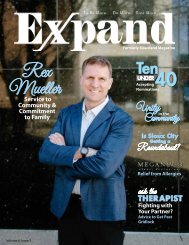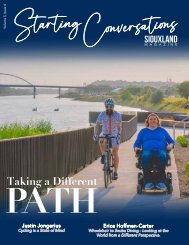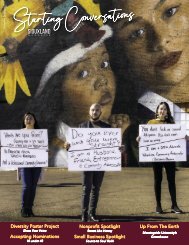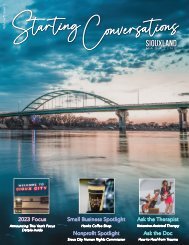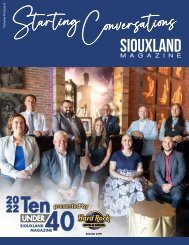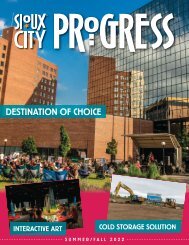You also want an ePaper? Increase the reach of your titles
YUMPU automatically turns print PDFs into web optimized ePapers that Google loves.
<strong>Siouxland</strong> <strong>Magazine</strong> | Balance /42<br />
No Struggle, No Strength<br />
By Dr. Meghan Nelson<br />
It’s important to consult your physician or physical therapist<br />
before beginning any new physical activity. Always listen<br />
to your body and respect any warnings you hear.<br />
“Where there is no struggle,<br />
there is no strength.”<br />
– Oprah Winfrey<br />
Sadly, all are probably too well familiar with the<br />
struggles that we can face as a country, a community, or<br />
as family members. Nearly every person I speak to these<br />
days is stressed out, hurt, scared, or confused by the<br />
chaos, the unknown, the struggles we face throughout<br />
this nation with jobs, health, relationships, school, the<br />
list goes on. The heavy loads that we all carry during a<br />
global pandemic alone are enormous strains and many<br />
are getting hit with forces from all directions, on all<br />
fronts.<br />
But is all the stress we face in life a bad thing? Can a<br />
crisis illuminate opportunities?<br />
How can we grow stronger without the stress? I am<br />
hopeful that what has been broken will be repaired.<br />
Somehow those fissures will all draw closer, the divisions<br />
disappear, and strength rebuilt where the struggle was<br />
the greatest. We just need to connect back with our<br />
foundation, our own strength within for that sense of<br />
stability and confidence to handle whatever will come<br />
our way. We are all going to come out of this stronger<br />
than ever. I have to believe this.<br />
This protocol is based on Wolff’s Law, after the German<br />
anatomist and surgeon from the 19th century, which<br />
states that bones will adapt to the stress placed on them.<br />
As you increase the load or increase the stress and<br />
strain, the bone will continue to remodel itself stronger<br />
and stronger in all the areas where stress is applied.<br />
This law is why we emphasize the benefits of weightbearing<br />
and resistance exercises throughout the aging<br />
process. Because the inverse of this is true as well, if one<br />
decreases the amount of load put throughout, the bones<br />
will lose mass and density and become weak and brittle.<br />
We can give resistance through moving the body<br />
and limbs through space, against gravity, using our<br />
body weight as resistance, bands, or dumbbells. The<br />
power and strength we can get behind the muscular<br />
contraction can come through an increase in neural<br />
motor connections. In other words, if we focus and<br />
use the mind-body connection we can recruit a larger<br />
number of nerve endings to fire efficiently and attract the<br />
greatest force from the muscle groups. This comes from<br />
mindfulness and repetition—the more we practice, the<br />
greater the neural muscular connection.<br />
Let’s begin.<br />
“There is a crack, a crack in everything.<br />
That’s how the light gets in.”<br />
– Leonard Cohen<br />
This is how the physical body works. We will never build<br />
strength in our muscles if we do not put these tissues<br />
through some stress. If we want to increase the bulk of<br />
our muscles, we first have to tear them down a bit. With<br />
the stress and strain put upon muscles, small muscle<br />
cells or fibers may be torn. The body then responds<br />
by sending new muscle cells to repair all of the little<br />
microtears that occurred, bulking up muscle mass. The<br />
more we build that resistance over time, the stronger<br />
the muscle grows.<br />
Our bones work in a similar way: to increase strength,<br />
we must increase stress. For individuals who have<br />
suffered from bone fracture, the strength of the bone<br />
was unable to withstand whatever load was given.<br />
Through physical rehabilitation, we can assist the<br />
remodeling process of fractured bone after it begins<br />
to heal. Your physical therapist will gradually introduce<br />
weight-bearing and resistance exercises to your plan of<br />
care to build up the strength at the fracture site from all<br />
angles.<br />
Mountain<br />
Mountain: This pose is the essence of stability and<br />
foundation; it can be done in many positions and is<br />
often found in other postures or poses. Engage core<br />
by maintaining a neutral spine with the navel drawing<br />
inward. Legs and arms are fully engaged with an open<br />
heart. Feel connected and grounded to the Earth, while<br />
lifting your crown to the Heavens. Feel solid, strong,<br />
like a mountain, nothing can knock you down. Breathe<br />
in this moment stability and strength.





